|
|
Photography, as a powerful medium of expression and communications, offers an infinite variety of perception, interpretation and execution. Ansel Adams
1 - Introduction
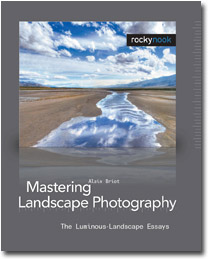
|
Photography is a passion. However this passion can be challenging at times and result in disappointing instead of rewarding images. This is because what we see in our mind is different from what the camera captures. The first thing to do to remedy this problem is learn the differences between what we see and what the camera captures. I cover this subject in my first book, Mastering Landscape Photography, so I will not go back over it here to avoid repeating myself.
In this series of essays I want to address the second thing we can do to remedy this situation: learn how to implement our vision in our photographs in order to make the photographs match what we see in our mind.
The goal of this series of essays is therefore to teach you how you can go from an idea in your mind -- i.e. your vision for a specific photograph -- to a physical print, or a screen image, that matches this vision. I will do that through both theoretical explanations and practical examples using my personal work.
Eventually, vision and by implication this series of essays, is about being yourself. However to be yourself and to create photographs that are about you, you need to acquire the necessary theoretical knowledge and technical skills. Providing you with this knowledge and these skills is what this series is all about.
2 - About Art
The underlying assumption here is that we are talking about creating fine art photographs and not documentary photographs. While I will return to this subject later in this series, I believe it is important to mention it from the get go. When approached as a fine art photography has a different goal than when approached as a form of documentation. Instead of aiming at representing the subject in a literal fashion, as it is seen by most people, the fine art photographer aims at representing the subject as it appears to him or her in their mind’s eye.
Rather than represent the subject literally, a fine art photographer aims at representing the subject emotionally. It is this focus on creating photographs based on emotion that makes all the difference. It this emotional focus that is at the root of vision. Rather than seek the creation of images based on a literal representation of the subject, fine art photographers seek the creation of images based on an emotional response to the subject. Rather than show us the subject as we already know it, the artist shows us the subject as only him, or her, knows it. What we see in the work of art is the subject transformed by the vision of the artist.
There is, of course, a significant challenge in doing so and this challenge is finding visual techniques that allow us to translate emotions visually. This is done through imagination, by discovering ways to make what starts in the mind of the artist visible to all in a photographic print. This is how vision comes out and explaining how this is done is the purpose of this series of essays.
3 - About Theory and Practice
This series of essays features both theory and practice. I decided to do this because I believe that both are necessary to a solid teaching approach. I am surprised at how few books and essays on photography published today feature theory. Most focus solely on practice, featuring technique after technique with little or no time spent on explaining why these technique are used. The problem is that while practice teaches you how to do something by using specific techniques, theory teaches you why to do something by giving you reasons for using specific techniques. Both theory and technique are necessary. In fact in my opinion they are inseparable.
4 - The Pillars of Vision
From a theoretical perspective vision is composed of three different elements:
- Subject choice– the subject you like to photograph
- Artistic approach – your unique way of rendering the subject during both field and studio work
- Technical virtuosity – your technical skills -- how well you implement your artistic choices
From a practical perspective vision is implemented through a set of 8 "pillars":
- Light quality
- Composition (including lens choice)
- Depth of field
- Exposure
- Raw file conversion (or film development)
- Image processing and optimization
- Printing
- Matting, framing and presentation
5 - What is Vision?
Vision is seeing what others do not see. Vision is also seeing something in our mind that is different from what is physically in front of us. Vision is something that starts in the mind, at the crossroads of what we see physically and what we imagine. Vision may be generated by the subject we are photographing. Or vision may cause us to look for a specific subject that we want to photograph.
Either way vision starts with an idea that later becomes a physical photograph. Imagination and creativity are at the origin of vision.
Vision and personal style are directly related. Vision is what we see in our mind. Personal style is how we represent what we see in our mind through photography or other medium.
Having a vision and a personal style is important in landscape photography because the vast majority of the locations we photograph are public places accessible by anyone. We are therefore bound to find many people photographing the same locations as us. When many people photograph the same locations, the difference between the work of several photographers is not their ability to photograph these locations. The difference is their vision of these locations, vision expressed through their imagination, their creativity and their personal interpretation of these places.
In other words if a multitude of people photograph the same locations, then photographing these locations does not make our work stand out. What makes our work stand out, what allows us to be ourselves, is having a unique vision for these locations and knowing how to express this vision through photography.
6 - Vision Example 1: Sand Waterfall
The practical part of this essay consists of an example of vision applied to a photograph titled Antelope Canyon Sand Waterfall.
This photograph was created with a Canon DSLR. This camera has an image format of 24mm x 36 mm. As I composed the image I realized that this format was not tall enough for my taste. I considered cropping the image to a taller format during conversion and optimization, however I also realized that I did not want to lose any part of the image. There just wasn’t anything I wanted to remove from the image. All I wanted to do is have a taller image.
The solution was to resize the image in Photoshop using Image>Image Size while unselecting 'constrain proportions.'
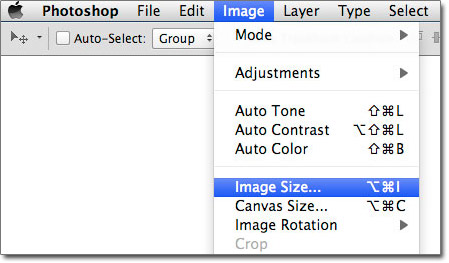
The image size menu command
I tried different sizes, all taller than the original format, until I found one that made the image look just the way I wanted.
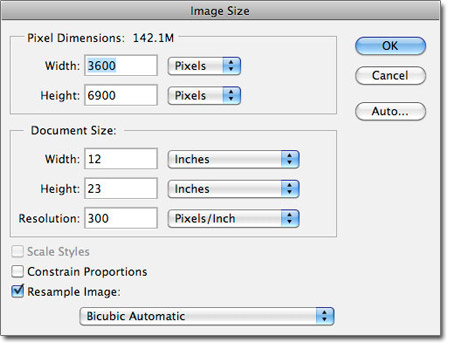
The image size dialog box showing the final stretched image size
The original image size was 11.52 x 17.58 I simplified these numbers by rounding the width to 12 and increasing the height to 23. I basically increased the height by 5 inches, a little more than 1/3rd of the original height. To follow this technique don’t forget to uncheck ‘Constrain Proportions’ otherwise you will be simply resizing the image, not modifying its format. Also be sure to check 'Resample Image.'
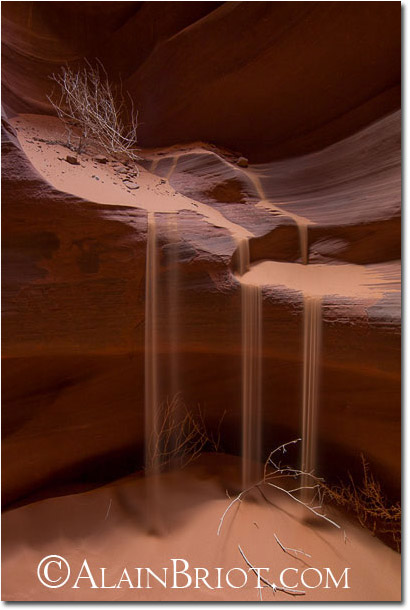 Antelope Canyon Sand Waterfall - Original Capture |
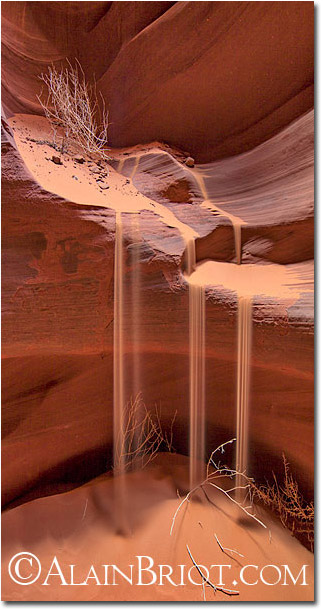 Antelope Canyon Sand Waterfall - Final Image |
The final image is much closer to my vision than the original capture. In this instance stretching the image through Image Size was all that was needed. In other instances a more involved process is required, using Photoshop transform functions such as distort, warp and other for example.
This is a relatively simple example of vision. In the next essays we will look at more complex examples. I chose this example to keep this article to a reasonable length since it features quite a bit of text.
The image went through other optimizations besides stretching through Image Size. The optimization process is started in the raw converter and continued in Photoshop through layer-based adjustments. These adjustment include curves, contrast masking, local contrast enhancement, color optimization and finally sharpening. The goal of these adjustments is two folds: first create a solid technical foundation for the image and second create an artistic interpretation of the image. I will detail this process later on in this series. As an aside, each essay in this series will feature at least one example.
The next essay on this series will focus on the importance of having an artist statement, including what is an artists statement and what to include in it when you write it. This essay will feature a second example of vision, this time using image stitching to achieve the desired composition and a larger field of view.
Alain Briot - NPN 2054
|
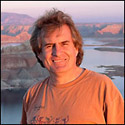 Alain Briot creates fine art photographs, teaches workshops and offers DVD tutorials on composition, conversion, optimization, printing and marketing photographs. Alain is also the author of Mastering Landscape Photography. Mastering Photographic Composition, Creativity and Personal Style and Marketing Fine Art Photography. All 3 books are available from Amazon and other bookstores as well from Alain’s website.
Alain Briot creates fine art photographs, teaches workshops and offers DVD tutorials on composition, conversion, optimization, printing and marketing photographs. Alain is also the author of Mastering Landscape Photography. Mastering Photographic Composition, Creativity and Personal Style and Marketing Fine Art Photography. All 3 books are available from Amazon and other bookstores as well from Alain’s website.
You can find more information about Alain's work, writings and tutorials as well as subscribe to Alain’s Free Monthly Newsletter on his website at http://www.beautiful-landscape.com To subscribe simply go to http://www.beautiful-landscape.com and click on the Subscribe link at the top of the page. You will have access to over 40 free essays by Alain, in PDF format, immediately after subscribing.
Alain welcomes your comments on this essay as well as on his other essays. You can reach Alain directly by emailing him at alain@beautiful-landscape.com.